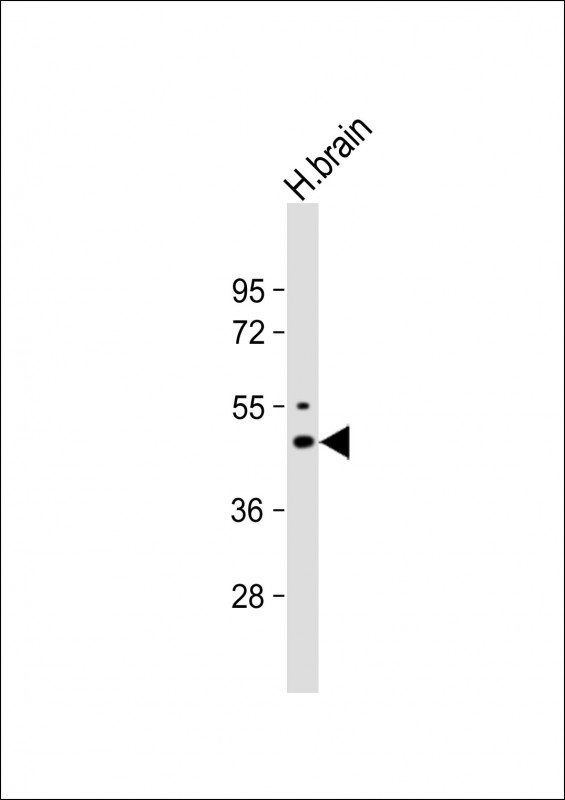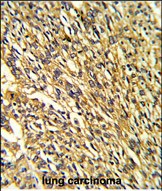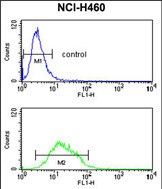KCNJ2 Antibody (C-term)
Affinity Purified Rabbit Polyclonal Antibody (Pab)
- 产品详情
- 实验流程
- 背景知识
Application
| WB, IHC-P, FC, E |
|---|---|
| Primary Accession | P63252 |
| Other Accession | Q64273, P49656, O18839, P35561, P52186, O19182 |
| Reactivity | Human, Mouse |
| Predicted | Bovine, Chicken, Pig, Rabbit, Rat |
| Host | Rabbit |
| Clonality | Polyclonal |
| Isotype | Rabbit IgG |
| Calculated MW | 48288 Da |
| Antigen Region | 401-427 aa |
| Gene ID | 3759 |
|---|---|
| Other Names | Inward rectifier potassium channel 2, Cardiac inward rectifier potassium channel, Inward rectifier K(+) channel Kir21, IRK-1, hIRK1, Potassium channel, inwardly rectifying subfamily J member 2, KCNJ2, IRK1 |
| Target/Specificity | This KCNJ2 antibody is generated from rabbits immunized with a KLH conjugated synthetic peptide between 401-427 amino acids from the C-terminal region of human KCNJ2. |
| Dilution | WB~~1:1000 IHC-P~~1:100~500 FC~~1:10~50 E~~Use at an assay dependent concentration. |
| Format | Purified polyclonal antibody supplied in PBS with 0.09% (W/V) sodium azide. This antibody is purified through a protein A column, followed by peptide affinity purification. |
| Storage | Maintain refrigerated at 2-8°C for up to 2 weeks. For long term storage store at -20°C in small aliquots to prevent freeze-thaw cycles. |
| Precautions | KCNJ2 Antibody (C-term) is for research use only and not for use in diagnostic or therapeutic procedures. |
| Name | KCNJ2 |
|---|---|
| Synonyms | IRK1 |
| Function | Inward rectifier potassium channels are characterized by a greater tendency to allow potassium to flow into the cell rather than out of it (PubMed:36149965, PubMed:7590287, PubMed:9490857). Their voltage dependence is regulated by the concentration of extracellular potassium; as external potassium is raised, the voltage range of the channel opening shifts to more positive voltages (PubMed:7590287, PubMed:7696590). The inward rectification is mainly due to the blockage of outward current by internal magnesium (PubMed:9490857). Can be blocked by extracellular barium or cesium (PubMed:7590287, PubMed:7696590). Probably participates in establishing action potential waveform and excitability of neuronal and muscle tissues (PubMed:7590287, PubMed:7696590, PubMed:7840300). |
| Cellular Location | Cell membrane; Multi-pass membrane protein Cell membrane, sarcolemma, T-tubule {ECO:0000250|UniProtKB:Q64273} |
| Tissue Location | Heart, brain, placenta, lung, skeletal muscle, and kidney. Diffusely distributed throughout the brain |
For Research Use Only. Not For Use In Diagnostic Procedures.
Provided below are standard protocols that you may find useful for product applications.
BACKGROUND
Potassium channels are present in most mammalian cells, where they participate in a wide range of physiologic responses. This protein is an integral membrane protein and inward-rectifier type potassium channel. This protein, which has a greater tendency to allow potassium to flow into a cell rather than out of a cell, probably participates in establishing action potential waveform and excitability of neuronal and muscle tissues. Mutations in this gene have been associated with Andersen syndrome, which is racterized by periodic paralysis, cardiac arrhythmias, and dysmorphic features.
终于等到您。ABCEPTA(百远生物)抗体产品。
点击下方“我要评价 ”按钮提交您的反馈信息,您的反馈和评价是我们最宝贵的财富之一,
我们将在1-3个工作日内处理您的反馈信息。
如有疑问,联系:0512-88856768 tech-china@abcepta.com.























 癌症的基本特征包括细胞增殖、血管生成、迁移、凋亡逃避机制和细胞永生等。找到癌症发生过程中这些通路的关键标记物和对应的抗体用于检测至关重要。
癌症的基本特征包括细胞增殖、血管生成、迁移、凋亡逃避机制和细胞永生等。找到癌症发生过程中这些通路的关键标记物和对应的抗体用于检测至关重要。 为您推荐一个泛素化位点预测神器——泛素化分析工具,可以为您的蛋白的泛素化位点作出预测和评分。
为您推荐一个泛素化位点预测神器——泛素化分析工具,可以为您的蛋白的泛素化位点作出预测和评分。 细胞自噬受体图形绘图工具为你的蛋白的细胞受体结合位点作出预测和评分,识别结合到自噬通路中的蛋白是非常重要的,便于让我们理解自噬在正常生理、病理过程中的作用,如发育、细胞分化、神经退化性疾病、压力条件下、感染和癌症。
细胞自噬受体图形绘图工具为你的蛋白的细胞受体结合位点作出预测和评分,识别结合到自噬通路中的蛋白是非常重要的,便于让我们理解自噬在正常生理、病理过程中的作用,如发育、细胞分化、神经退化性疾病、压力条件下、感染和癌症。









